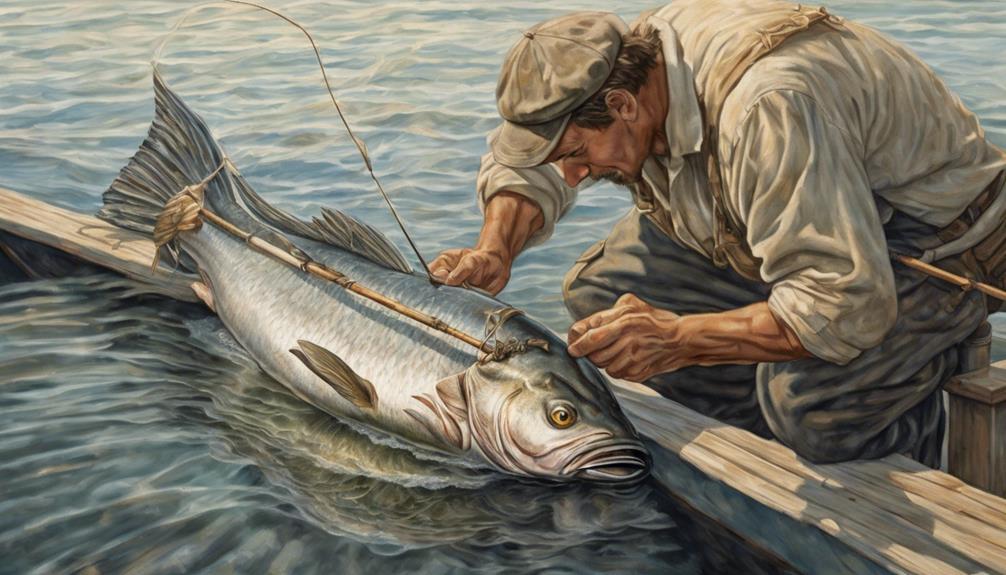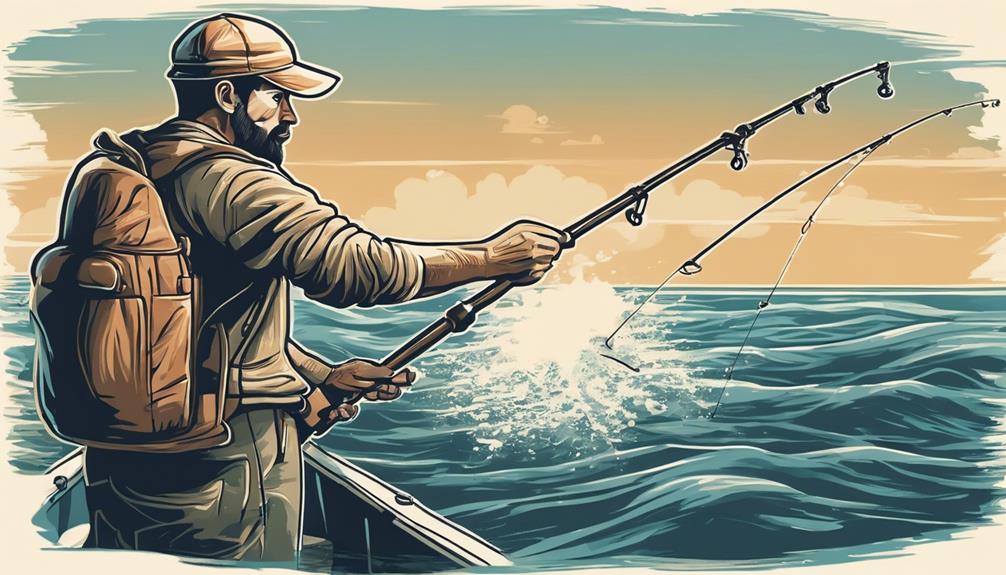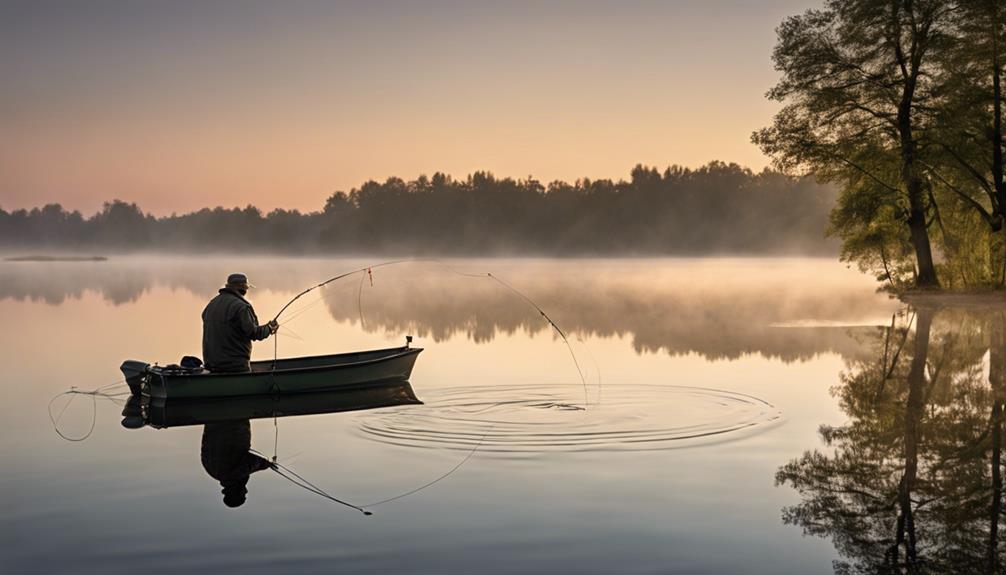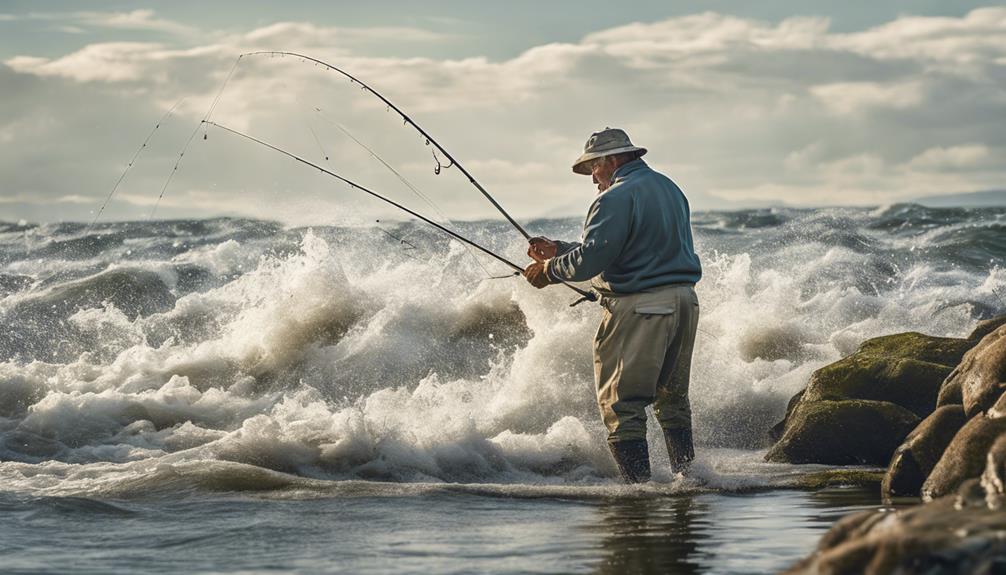When it comes to deep sea fishing, the ocean is your playground, but navigating it effectively requires a blend of skill and strategy.
From choosing the right gear to mastering casting techniques, each aspect plays a crucial role in your success on the open waters.
Whether you're a seasoned angler or setting sail for the first time, understanding the intricacies of deep sea fishing can make all the difference between coming back empty-handed or reeling in the big catch.
Choosing the Right Equipment
When preparing for deep-sea fishing, ensure you have the appropriate gear to maximize your chances of success. Equipment maintenance is crucial for a successful fishing trip. Before heading out, check your rods and reels for any signs of wear and tear. Ensure they're clean and properly lubricated to prevent any malfunctions while out on the water. Proper maintenance won't only extend the life of your equipment but also help you avoid any unexpected issues that could cost you a catch.
Rod selection plays a vital role in deep-sea fishing. Different rods are designed for specific types of fish and fishing techniques. Make sure you choose a rod that matches the species you're targeting and the style of fishing you plan to do. A heavy-duty rod is ideal for larger fish such as marlin or tuna, while a lighter rod works well for smaller species like mackerel or snapper. Selecting the right rod won't only make your fishing experience more enjoyable but also increase your chances of landing that prized catch.
Proper rigging and bait presentation are essential skills to master for deep-sea fishing. Make sure your rigs are set up correctly to attract the fish you're targeting. Pay attention to details such as the size and type of hooks, the weight of the sinkers, and the placement of the bait. By presenting your bait in a natural and enticing way, you're more likely to entice the fish to strike, leading to a more successful fishing excursion.
Understanding Weather and Tides
To enhance your deep-sea fishing skills, understanding weather patterns and tides is crucial for a successful and safe fishing expedition. Tidal patterns play a significant role in deep-sea fishing. Knowledge of high and low tides can help you determine the best times to fish as certain species are more active during specific tidal phases.
Additionally, being aware of wind speeds is essential. Strong winds can create rough waters, making fishing challenging and potentially dangerous. Checking weather forecasts for wind conditions before heading out is a smart practice.
Barometric pressure is another key factor to consider. Fish are sensitive to changes in pressure, and low pressure often signifies stormy weather which can affect fish behavior. Understanding how barometric pressure influences fish can help you adjust your fishing strategies accordingly.
Moon phases also impact fishing success. Full moons, for example, can increase fish activity at night, while during new moons, fish may be less active. Planning your fishing trips around moon phases can improve your chances of a good catch.
Targeting the Right Fish Species
Understanding the habits and preferences of different fish species is essential for successful deep-sea fishing expeditions. When targeting the right fish species, it's crucial to consider factors such as fish behavior, species selection, depth, and location targeting. Here are five key points to help you improve your chances of landing the right catch:
- Research Fish Behavior: Different fish species exhibit unique behaviors, such as feeding patterns, preferred water temperature, and ideal bait choices. Understanding these behaviors can significantly increase your chances of success.
- Select the Right Species: Choose the fish species you want to target based on your preferences and the season. Some species are more abundant during specific times of the year or in particular locations.
- Consider Depth: Certain fish species prefer specific depths in the water column. Adjust your fishing techniques and equipment to target fish at their preferred depths effectively.
- Identify Ideal Locations: Research the best locations for the species you're targeting. Factors such as underwater structures, currents, and temperature variances can help you pinpoint the most promising fishing spots.
- Adapt Your Approach: Be prepared to adapt your fishing techniques based on the behavior and preferences of the fish species you're targeting. Experiment with different baits, lures, and fishing styles to maximize your chances of success.
Mastering Deep Sea Casting
To excel in deep sea fishing, mastering deep sea casting is essential for accurate and successful targeting of fish species at varying depths. Improving accuracy and increasing distance in your casts can significantly enhance your chances of a successful catch.
When aiming to improve accuracy in deep sea casting, focus on your technique. Ensure that your casting motion is smooth and controlled, utilizing the power of both your arm and wrist to propel the bait or lure precisely where you want it to go. Practice regularly to hone your skills and develop muscle memory for consistent and accurate casts.
Increasing distance in deep sea casting can be achieved through a combination of proper technique and equipment. Use a rod with the appropriate length and action for the type of fishing you're doing, as well as a quality reel that allows for smooth line release. Additionally, pay attention to the angle of your cast and the amount of force you apply to maximize the distance covered.
Using Live Bait Vs. Lures
Mastering deep sea casting opens up the decision between using live bait or lures to entice your target fish effectively. When debating whether to use live bait or lures on your deep-sea fishing adventure, consider the following key points:
- Bait Preference: Some fish species have a strong preference for live bait due to its natural movement and scent, which can be more enticing to certain predators.
- Effectiveness of Live Bait: Live bait can be highly effective in attracting larger, more cautious fish that may be wary of artificial lures.
- Lure Selection: Lures offer a wide variety of shapes, sizes, and colors, allowing you to mimic different types of prey and adapt to changing fishing conditions.
- Advantages of Lures: Lures are reusable and can save time and effort in obtaining fresh live bait, making them convenient for longer fishing trips.
- Matching the Hatch: Choosing a lure that closely resembles the fish's natural prey can increase your chances of a successful catch, as it can trigger a predatory response.
When deciding between live bait and lures for deep sea fishing, consider the specific characteristics of your target species, the prevailing fishing conditions, and your personal preferences to optimize your chances of a successful and rewarding fishing experience.
Drifting and Trolling Techniques
For effective deep sea fishing, incorporating drifting and trolling techniques can significantly enhance your chances of catching various species of fish. When utilizing these techniques, boat navigation plays a crucial role. To effectively drift, you need to consider the direction and speed of the current. Understanding the current speed will help you determine the best spots to drift over, maximizing your chances of attracting fish.
When drifting, it's essential to adjust your fishing depths according to the targeted species. Different fish species occupy various depths, so adapting your bait presentation to the right depth can make a substantial difference in your catch. By varying the depth of your bait, you can entice a wider range of fish to bite.
Trolling, on the other hand, involves moving your boat at a slow to moderate speed while dragging bait or lures behind. Similar to drifting, adjusting the depth at which your bait or lures are presented is crucial when trolling. This technique allows you to cover more ground, increasing the likelihood of encountering active fish.
Handling Fish and Releasing Safely

When handling fish during deep sea fishing, ensure you prioritize their safe release back into the water to maintain sustainable fishing practices. Understanding fish behavior and employing proper techniques are crucial for ensuring the fish's survival after being caught.
- Observe Fish Behavior: Take note of how the fish is reacting when handling it. Some fish species may be more stressed or agitated than others, requiring gentler handling techniques.
- Use Proper Handling Techniques: Avoid touching the fish's gills or eyes, as these are sensitive areas. Support the fish properly when lifting it out of the water to prevent injury.
- Minimize Air Exposure: Keep the fish in the water as much as possible to prevent it from suffocating. Quick and efficient handling reduces stress on the fish.
- Remove Hooks Carefully: Use proper tools like long-nose pliers to safely remove hooks from the fish's mouth. Avoid causing unnecessary harm during the process.
- Release Fish Safely: When releasing the fish, hold it in the water upright and gently move it back and forth to help oxygenate its gills. Ensure the fish swims away strongly before letting go.
Safety Tips for Deep Sea Fishing
To enhance your deep sea fishing experience, prioritize safety by familiarizing yourself with essential tips and precautions. When venturing into the deep sea, it's crucial to be prepared for any unforeseen circumstances. Begin by familiarizing yourself with emergency protocols. Ensure that everyone onboard knows where the life jackets are located and how to use them. Instruct your crew on how to send distress signals and operate emergency equipment in case of an urgent situation.
Additionally, stocking your vessel with first aid essentials is paramount. Make sure you have a well-equipped first aid kit that includes items such as bandages, antiseptic wipes, pain relievers, seasickness medication, and any necessary prescription medications for members of your party. Familiarize yourself with how to use these supplies to address common injuries or ailments that may occur during your deep sea fishing trip.
Frequently Asked Questions
How Can I Prevent Seasickness While Deep Sea Fishing?
To prevent seasickness while deep sea fishing, consider trying natural remedies like ginger or peppermint. You could also take medication specifically designed for motion sickness.
Breathing techniques and acupressure may help alleviate symptoms. It's important to stay hydrated and avoid heavy meals before your trip. Remember to focus on the horizon and get some fresh air whenever possible.
Experiment with different strategies to find what works best for you.
Are There Any Regulations or Restrictions I Should Be Aware of Before Going Deep Sea Fishing?
Before venturing into deep sea fishing, it's crucial to understand fishing regulations and conservation efforts that apply. Make sure you have the necessary licensing and permits to avoid any legal issues.
Familiarize yourself with size limits, bag limits, and protected species to ensure you're fishing responsibly. Following these guidelines not only keeps you on the right side of the law but also helps in preserving marine ecosystems for future generations.
What Are Some Common Mistakes Beginners Make When Deep Sea Fishing?
When deep sea fishing, beginners often make common mistakes like improper baiting and struggling with fish identification. Remember to take safety precautions seriously and maintain your gear regularly.
These errors can impact your fishing experience, so pay attention to details. By honing these skills, you can enhance your fishing success and enjoyment on the open sea.
How Do I Properly Maintain and Store My Fishing Equipment After a Deep Sea Fishing Trip?
After a deep sea fishing trip, make sure to properly clean your fishing equipment to prevent corrosion. Rinse rods, reels, and tackle with fresh water, then dry them thoroughly.
Store gear in a cool, dry place to avoid rust and damage. Use rod holders or racks to keep rods organized and prevent bending.
Proper cleaning and storage techniques will help extend the life of your fishing equipment and keep it in top condition for your next adventure.
Are There Any Specific Techniques for Handling and Releasing Deep Sea Fish to Minimize Harm to Them?
When it comes to fish handling and conservation in deep-sea fishing, it's crucial to practice ethical practices for catch and release.
Properly handling fish, using barbless hooks, and minimizing air exposure can help reduce harm to the fish. Make sure to keep the fish in the water as much as possible, handle them gently, and release them quickly.
These techniques promote conservation and ensure the fish have a higher chance of survival after being caught.
Conclusion
Now that you have learned about the best techniques for deep sea fishing, it's time to put your knowledge to the test. Remember to choose the right equipment, understand weather and tides, target the right fish species, master your casting skills, and decide between live bait and lures.
Practice drifting and trolling techniques, handle fish with care, and always prioritize safety. Get out on the water and enjoy the thrill of deep sea fishing!



